If you’re welcoming the intelligent, determined, and affectionate bluetick coonhound into your home, you may be wondering what to expect from this breed’s development. In this guide, we’ll discuss bluetick coonhound progression, crucial milestones, and tips for raising a healthy, happy, and well-rounded hound.
Read on to learn more!
Bluetick Coonhound Progression: Breed Summary
Like all coonhounds, the bluetick originated in the U.S., bred to track and hunt game over long distances. While the AKC officially recognized the bluetick coonhound as a distinct breed in 2009, the breed’s origination likely dates back to Louisiana in the early 1900s. There, to produce the bluetick coonhound, breeders mixed the Bleu de Gascogne staghound of Southwest France with the English foxhound, an American foxhound, black and tan Virginia Foxhound, and treeing cur. Blueticks are cold-nose scent hounds, meaning they are capable of carefully following trails that are hours or even days old. The breed has changed little since its development.
Breed Standards
According to the AKC breed standards, the bluetick coonhound should appear swift, lean, and well-muscled. The coat is smooth, glossy, and of medium coarseness. The preferred coat color is dark blue and densely mottled with black spots on the back, ears, and sides. More blue than black should cover the coat. Tan ticking may appear over the eyes, on the cheeks, chest, and below the tai. Red ticking may appear on the feet and lower legs. The eye should express an alert intelligence. The head and tail should be carried high. The gait should express enthusiasm and ease of movement. Their voice is typically described as a bawl of medium depth.

The Bluetick coonhound is a swift, lean, and well-muscled scent hound.
©Mark Riordan / public domain – License
Bluetick Hound Progression: Growth Chart
The below chart describes an average growth estimation for female and male bluetick coonhounds, beginning at 2 months old. Please note that genetic variations and diet can affect your dog’s ultimate weight at maturity.
| Age | Female Bluetick Coonhound Weight | Male Bluetick Coonhound Weight |
|---|---|---|
| 2 months | 5-10 lbs. | 10-15 lbs. |
| 3 months | 12-15 lbs. | 18-25 lbs. |
| 4 months | 16-20 lbs. | 22-38 lbs. |
| 5 months | 20-30 lbs. | 30-46 lbs. |
| 6 months | 23-35 lbs. | 32-50 lbs. |
| 7 months | 27-41 lbs. | 36-55 lbs. |
| 8 months | 30-45 lbs. | 40-60 lbs. |
| 9 months | 33-49 lbs. | 42-63 lbs. |
| 10 months | 35-53 lbs. | 45-65 lbs. |
| 11 months | 37-55 lbs. | 48-67 lbs. |
| 12 months | 40-60 lbs. | 50-70 lbs. |
| 24 months | 45-65 lbs. | 55-80 lbs. |
When Will My Bluetick Coonhound Stop Growing?
As a large breed dog, your bluetick coonhound will likely reach physical maturity at about 18-24 months of age. Regularly scheduled checkups with your vet will help ensure that your pup is developing at a healthy rate.
How many calories an adult coonhound should intake each day can vary widely based on their activity level and where they fall within their weight range. For example, a moderately active 80lb adult male coonhound may need up to about 1,500 calories per day. However, during an active hunt, an 80lb bluetick coonhound could burn about 2,000 calories, so feeding schedules and amounts will need to be adjusted depending on the pup’s activity levels. Make sure to always provide fresh, clean water throughout your dog’s life.
Bluetick Hound Progression: How Big Will My Bluetick Hound Be When It’s Fully Grown?
According to the AKC, you can expect a healthy, adult female bluetick coonhound to measure 21-25 inches tall at the shoulders and weigh 45-65 pounds. For a healthy, adult male bluetick, the average height is 22-27 inches tall at the shoulders and the average weight is 55-80 pounds.

Depending on whether your pup is a male or female, a healthy adult bluetick coonhound can weigh 45-80 pounds.
©Mary Swift/Shutterstock.com
When Should My Bluetick Coonhound Be Spayed or Neutered?
The question of when to spay or neuter your dog is best answered by considering the specific breed and individual dog. Modern research demonstrates that spaying and neutering can offer some health benefits as well as several health risks. Altering your bluetick coonhound also ensures that your dog does not contribute to the overpopulation of dogs in countries like the U.S. where about 400,000 shelter dogs are euthanized every year, almost entirely for lack of space in the shelter.
However, the possible increased health risks specifically associated with spaying and neutering under 1 year of age should not be taken lightly. These conditions include bone and joint diseases and some cancers. While widespread studies on the effects of early spay and neuter do exist, none so far include the bluetick coonhound or closely related breeds. However, bluetick coonhounds do face an increased risk of developing joint diseases such as hip dysplasia. It can take about 16 months for growth plates to fully close in large breed dogs such as the bluetick coonhound. Given this info, it’s best to consult with an informed vet on the safest time to alter your bluetick.
Bluetick Coonhound Progression: When Should My Bluetick Be House Trained?
As with other dog breeds, your bluetick coonhound can begin potty training in earnest at 8 weeks of age. At this age, your puppy can only hold their bladder and bowels for about 2 hours, regardless of training. This maximum time increases by about an hour per month until they reach about 6-8 months old. To best ensure success with potty training, make sure to take your puppy outside every 2 hours and immediately after they eat or drink lots of water. You can also leave puppy pads near the door and in proximity to their sleeping area at night.
In the case of an accident, it’s crucial to not punish or scold your puppy. Accidents are a part of potty training and punishing your pup can harm your relationship and cause your puppy to feel anxious about elimination. When your puppy has an accident indoors, try your best to simply clean up the mess and speak in calm, neutral tones. Then, increase how often you take your puppy outside and provide lots of love, treats, and play when they go to an appropriate place.
When Should My Bluetick Coonhound Stop Eating Puppy Food?
Since bluetick coonhounds are a large breed of dog, they’ll need to continue eating puppy food until about 15-18 months of age. Puppy food is formulated to meet the higher protein and calorie-dense needs of growing pups. If you switch to adult food too early, you can accidentally deprive your puppy of much-needed nutrients during their crucial developmental period.
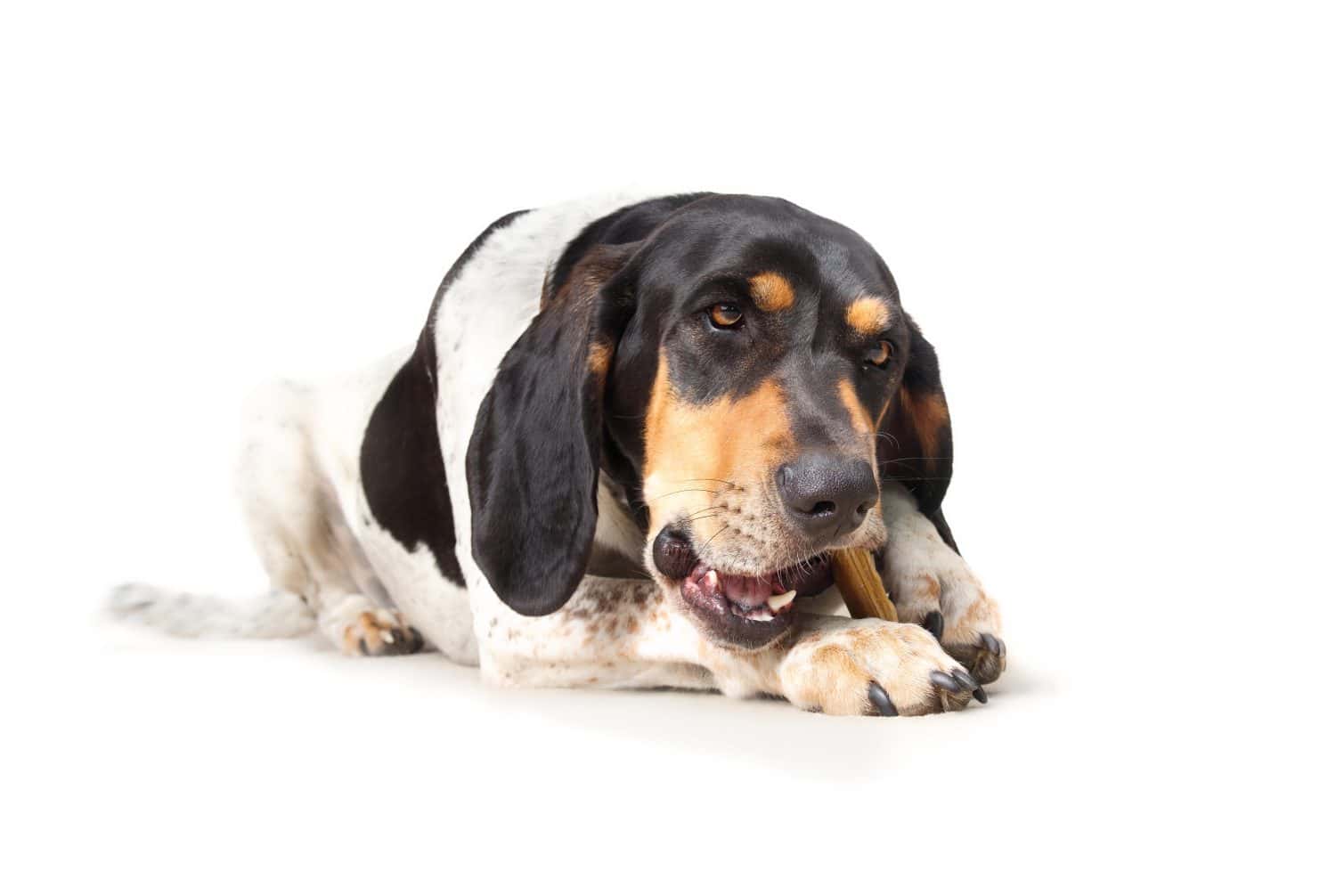
You can begin transitioning your bluetick coonhound to adult food when they’re around 15-18 months of age.
©sophiecat/Shutterstock.com
Bluetick Coonhound Progression: When Will My Bluetick Coonhound Start Losing Teeth?
At about two weeks old, primary puppy teeth will start erupting from your bluetick’s gums. By 8-10 weeks of age, they have a full set of 28 puppy teeth that includes their incisors, canines, premolars, and molars. Around 12 weeks of age, your bluetick will start losing their puppy teeth. In its place, a set of 42 adult teeth will erupt from the gums over about 3-4 months.
Teething Period
As the adult teeth erupt, your puppy will likely seek out items to chew to soothe their gums. It’s important to provide a range of safe chew toys of various textures. Frozen carrots and plan mini bagels are another great option. The more options you provide, the less likely your pup is to seek our shoe closet. If you do find your puppy chewing on an inappropriate item, simply trade them for a suitable chew toy. If you only take away items from your puppy without giving them something of equal or better value, you risk damaging your relationship and can cause habitual resource-guarding behaviors to develop.
When Should I Start Training My Bluetick Coonhound?
Short, fun, non-forceful, and easy-to-digest training sessions can begin with your bluetick coonhound puppy at 8 weeks of age. These sessions should only last a couple of minutes and focus on strengthening your bond and helping your puppy learn skills for navigating our human-dominated world. While teaching cues through positive reinforcement is a useful part of raising a well-rounded puppy, it is often far overemphasized in comparison to early socialization and building a secure attachment bond.
Modern dog behaviorists are focusing more than ever on emphasizing the need to help your puppy grow up feeling safe and secure in our world over producing dogs with robot-like obedience. Finally, make sure your bluetick puppy is getting plenty of sleep during their development. Training sessions should not take priority over ensuring an 8-week-old puppy receives about 20 hours of sleep per day.
Bluetick Coonhound Progression: What Cues Should I Teach My Bluetick Coonhound First?
Especially during puppyhood, you should prioritize teaching cues that help your puppy more safely navigate the world. Teaching a solid recall is an important part of ensuring this safety, especially for scent hounds who are more likely to want to roam and follow their nose. You can also teach your bluetick to respond to a whistle if you plan on working them in remote areas where they may go out of sight. The best way to teach whistle recall is to form a positive association with the whistle. This way, when they hear the whistle they will want to come running back to you to receive a tasty reward or favorite toy.
Especially for this breed, it’s also a good idea to teach impulse regulation cues, such as “wait”. You can begin teaching this by slowly lowering a treat towards them while saying “wait” in a calm, drawn-out voice. Then, open your palm containing the treat and say a release word, such as “free!” in a cheerful, active voice. This will encourage your puppy to wait and then move to get the treat at the release word.
Finally, since blueticks can be easily distracted by critters such as squirrels, you can begin working on teaching cues to direct their attention to you in increasingly distracting environments. Start with a distraction-free environment and use a cue such as “watch me” while holding a treat in front of your face. The second your puppy looks at you, say “yes!” or another marker word and then quickly deliver the treat. Once your puppy understands the “watch me” cue means to direct their attention to you, then you can slowly, and incrementally build up the distraction intensity in the environment.
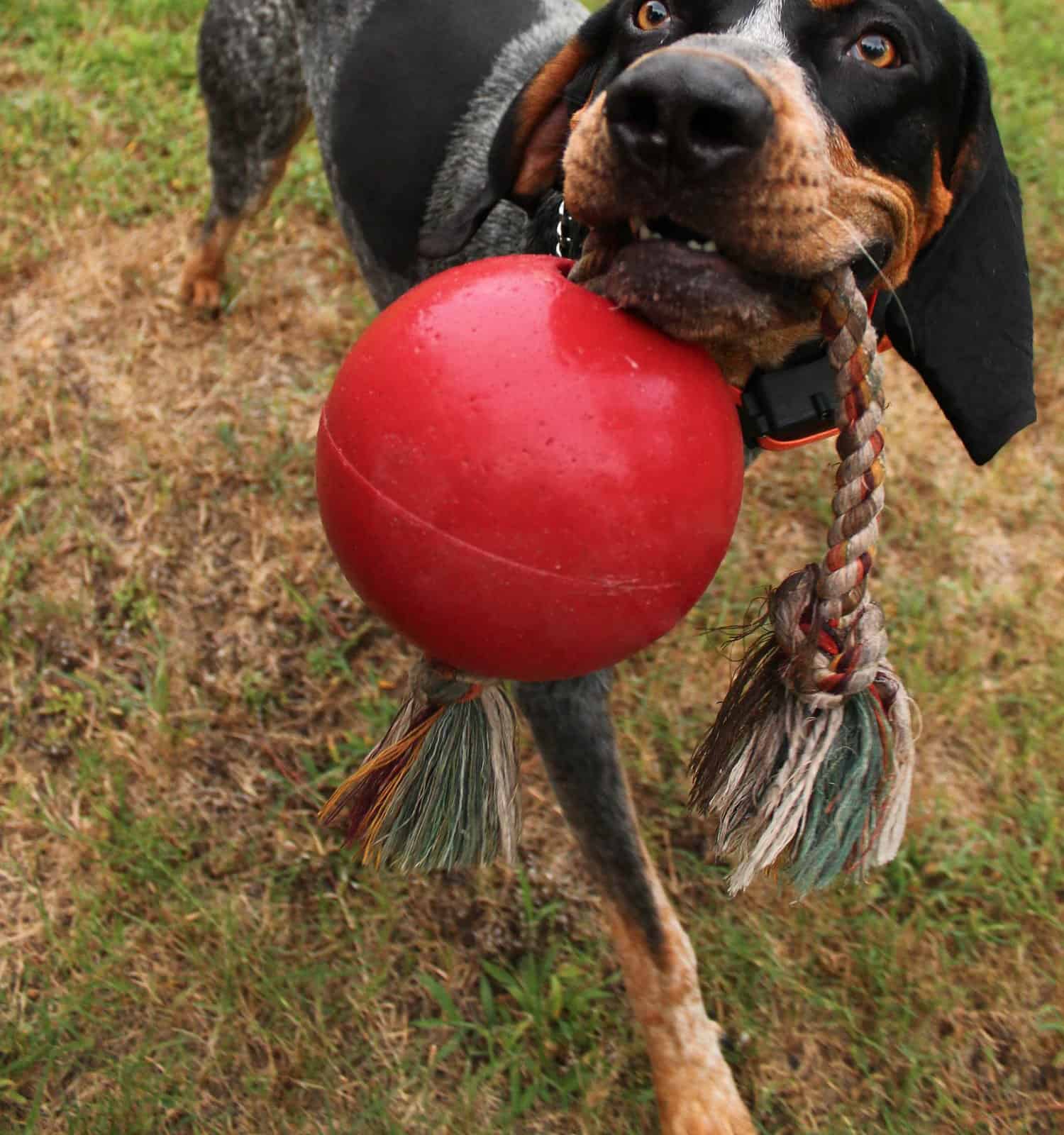
Use high-value toys and treats to reinforce a solid recall cue with your Bluetick coonhound.
©Taylor Walter/Shutterstock.com
When Will My Bluetick Coonhound Calm Down?
Regarding bluetick coonhound progression, dogs of this breed reach full social maturity at about 3 years old. You may find that they don’t have as much puppy or adolescent energy around this time. However, if your bluetick coonhound doesn’t have consistent access to what they need to thrive, you may find that they have a difficult time settling or feeling calm.
If your adult bluetick coonhound seems hyperactive and has difficulty settling down, ask yourself if they have consistent access to the following:
- Social companionship
- Scent and food-based enrichment and the opportunity to explore novel environments
- Play
- Voluntary exercise
- Restorative sleep, including restful naps during the day
- Nutritious food and fresh water
- Access to chew toys and enrichment toys
- Comfortable safe, shelter that they can freely come and go from
- Freedom from punishment-based and aversive training methods (including shock collars, prong/pinch collars, etc.)
- Predation substitute enrichment if needed (useful for hounds with high prey drives)
You may notice that your bluetick coonhound is quite vocal and is eager to explore the environment with their nose. It’s important to give them consistent outlets to vocalize and practice scent-based skills. If you don’t enjoy sharing space with vocal dogs, a bluetick may not be the best canine companion for you, as they frequently communicate with their delightful bawls and howls.
If you don’t have access to much green space to let your pup explore, it’s a great idea to start practicing scent games around the home and yard. Many of these games involve hiding dog-safe scents for your pup to find and rewarding them once they locate the scent. These games are easy to set up in houses and can be an excellent way of ensuring your bluetick has what they need to feel calm and content in their life.
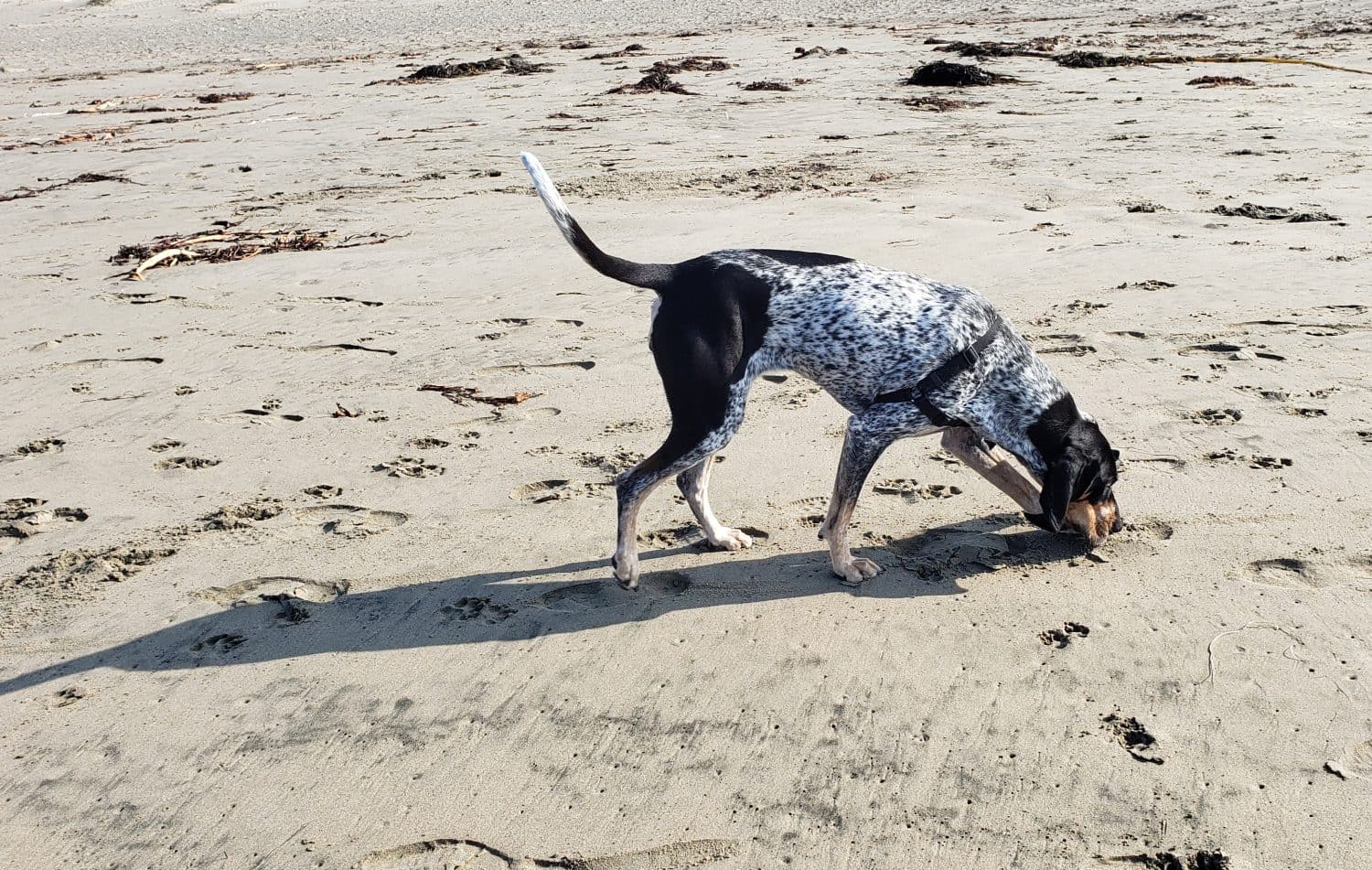
To support your pup in feeling calm and content, it’s important to give them plenty of opportunity to work their fabulous nose.
©mark__graham/Shutterstock.com
Bluetick Coonhound Progression: Common Health Issues Your Bluetick Coonhound Might Experience
Bluetick coonhounds have an average life expectancy of 10-12 years. They are generally healthy pups although this breed does face an increased risk of some common genetic health conditions. The following are health conditions that commonly affect blueticks:
- Hip dysplasia
- luxating patella (disorder of the kneecap)
- Elbow dysplasia
- Hypothyroidism
- Ear infections
- Bloat
- Dental disease
- Cataracts
As you may have noticed, joint and bone diseases are especially common in bluetick coonhounds. For this breed, it’s important to look for any changes in gait, no matter how subtle, or a sudden reluctance to hop on or off the couch. You can always ask your vet how to best support the health of your dog’s bones and joints. If you notice any sudden behavioral changes, it’s always a good idea to set up a thorough vet exam to rule out any underlying medical conditions.
Picture of a Bluetick Coonhound Puppy
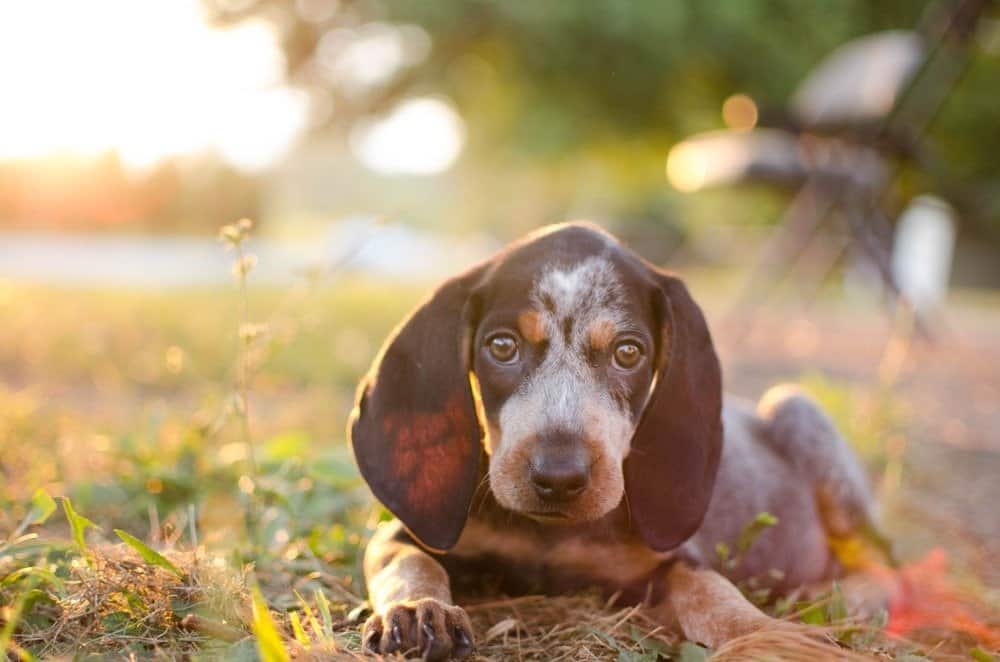
A bluetick puppy with adorably oversized ears.
©Kiana Skojec/Shutterstock.com
Photo of a 6-month-old Bluetick Coonhound
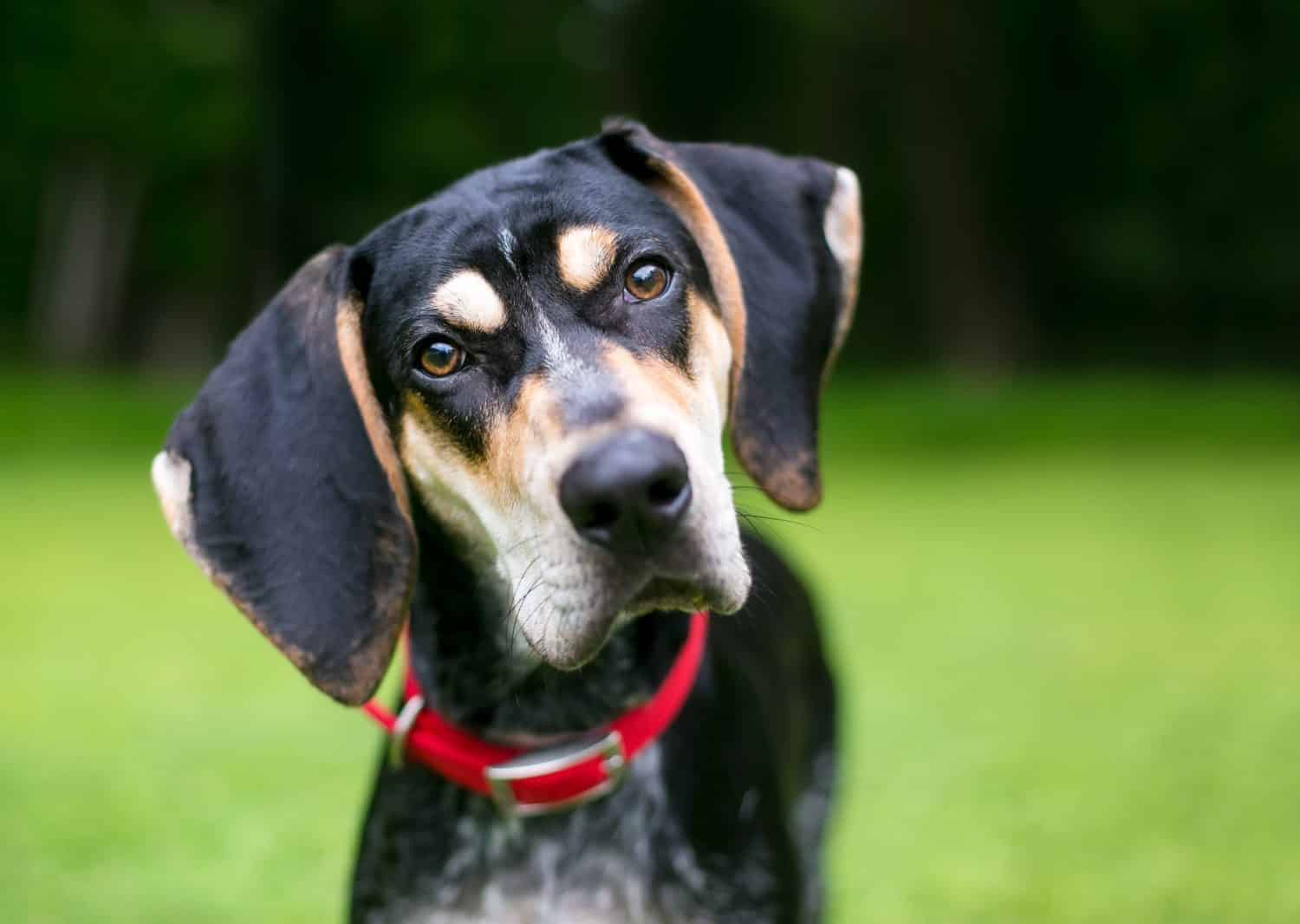
An alert, curious 6-month-old bluetick coonhound.
©Mary Swift/Shutterstock.com
Picture of an Adult Bluetick Coonhound

An adult Bluetick coonhound happily resting.
©Taylor Walter/Shutterstock.com
The photo featured at the top of this post is © Mary Swift/Shutterstock.com
Ready to discover the top 10 cutest dog breeds in the entire world?
How about the fastest dogs, the largest dogs and those that are -- quite frankly -- just the kindest dogs on the planet? Each day, AZ Animals sends out lists just like this to our thousands of email subscribers. And the best part? It's FREE. Join today by entering your email below.
Thank you for reading! Have some feedback for us? Contact the AZ Animals editorial team.






